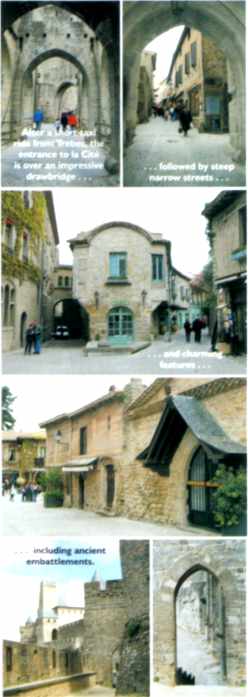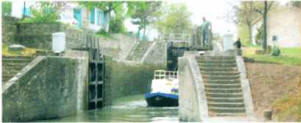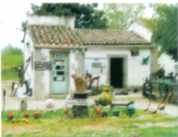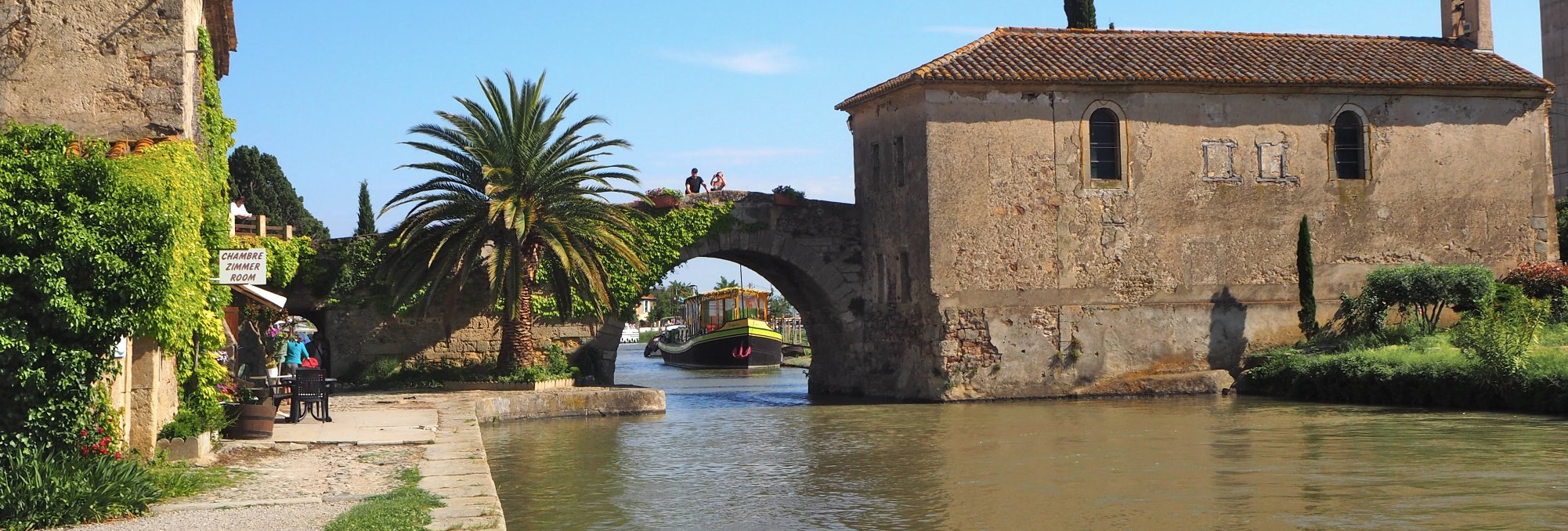
Wide boat to Carcassone
Stretching over 150 miles from the Atlantic Ocean to the Mediterranean Sea, France's Canal du Midi sets an imposing route across an open landscape.
CHRIS DANIELS and crew set out from a hire base in the wine- making Minervois region
above (left to right)
This complementary bottle of local wine was left on board our boat
Minervois Cruisers' base at Le Somail is on the right, still in early April.
In the 18th Century, Le Somail was a staging post on the packet boat route from Agde to Toulouse. This former ice house dates from that time.
Tucked away on the offside of the cananl at Le Somail is this ginny, which once raised water from an underground aquifer.

Although I have travelled on most of the waterways of the UK over the last 35 years, my experience of continental waterways has been somewhat limited - so the suggestion of a break with a company offering British-built steel boats on France's Canal du Midi was just too hard to resist.
Minervois Cruisers was established at le Somail, towards the southern end of the Canal du Midi, in the early 1990s. The company was acquired by Howard & Ann Davies, owners of the UK's twin-base Napton Narrowboats, in 2003. Since then, the fleet has been upgraded, modernised and expanded
With the growth of large multi-base hire operations, Minervois is still the only hire fleet in southern France specialising in British- built steel narrowboats ('Midi-Explorers') and wide-beam canal craft ('Sovereigns'). It is now one of only a few independent family- owned hire boat businesses on the Canal du Midi.
Our party consisted of me as 'captain', and my wife and brother as 'crew'. Our trip was scheduled for early April, and we chose to fly Ryanair to Carcassonne, although Narbonne airport is also not too far away. Organised by the boatyard, a simple €90, 45-minute. taxi transfer to the Minervois Cruisers base at le Somail then led to something of a dilemma: do we go south to the Mediterranean, or head west towards Carcassonne?
Having read Terry Darlington's amusing book Narrow Dog to Carcassonne, a chance to share some of his experiences certainly appealed -and we had friends based within easy traveling distance of the area who knew something of Carcassonne's history. So. despite my wife's protestations that she wanted some early-year Mediterranean sunshine. there was really no choice but to head north west for 'la Cité'!
Getting underway
We arrived at the boatyard a little late on Saturday afternoon, and English managers Emily and Tony were probably quite relieved when we suggested that we did the formal 'handover' the following morning. That left us a chance to settle in on the boat, and to explore a little of the surroundings of the charming village of Le Somail
The village is full of history and character, and dinner that night was in a delightful waterside restaurant. This not only put us in a holiday mood, but also put all of our schoolboy/girl French lo the test as English was clearly not spoken. This first night experience was to give us confidence for the week ahead, and we coped!
Our allocated boat, the appropriately named Carcassonne, was a 'Sovereign' class eight-berth wide-beam steel vessel. The boat was very well equipped. and had two fixed double berths, a twin berth, and a 'put-you-up' double berth in the rear saloon. With an en-suite bathroom and toilet, and a further bathroom and separate toilet. our party of three was quite happy with the arrangements However, we imagined that with any more than six on board, the confines might put a strain on even the strongest of friendships.
below (left to right)
This delightful floating shop has a wide range of loacally-grown produce.
Lined with mature plane trees, the former towpath has been upgraded.
Having stopped to shop at Parazza, we arrived at our first lock at Argens during the lock-keeper's lunch break.


above (left to right)
Right on time, monsieur l'éclusier was back on duty and lowered three glass-fibre cruisers down. We bought locally produced honey from his wife's small lockside shop.
The imposing tower of the church at Puicheric is visible through the trees and across vineyards for some miles around.
Seemingly too little too late, this bridge protection roller bore few signs of tow ropes, the bridge however was well marked

Sturdy bikes were an optional extra, which we declined at handover although there were occasions during our week-long trip when a bike would have been of use. Also worth mentioning ts that Minervois Cruisers offers a two-bedroomed house at the wharf at le Somail. Emily told us that several of their customers took the option of a week in the house and a week on a boat. However, a car is essential for further exploration.
All three of us being more used to narrowboats. the wide-beam Carcassonne came as a bit of a surprise when we had our 'official handover' the next morning. Handling a wide boat with wheel steering was an interesting experience, but the fact that the wheel is on an upper deck, and the steerer actually had a seat which was only slightly aft of the boats pivot point, certainly took a little getting used to. However, we all soon got out of the 'tiller' mode, and the boat was actually quite easy, if a little heavy, to handle.
Canal character
Our early April trip coincided with France's annual 'mistral' winds, which blew in from the surrounding mountains. On a contour canal, with more dogleg bends than Mr Brindley's Oxford Canal summit level could ever produce, this made for some taxing trials for those at the wheel, but then it at added to our fun and enjoyment!
The Canal du Midi is lined, at least for most of the length that we travelled, with mature plane trees. Whilst these can act as something of a windbreak, one can't help feeling that their presence detracts from otherwise spectacular views across wonderful open countryside, and field upon field of vineyards in this predominantly wine producing region. Much of the former towpath has been upgraded, and is now recognised, and regularly used, as a cycleway.
All locks on the canal are manned, and are electrically operated by a lock-keeper, or éclusier. Lock landings are only small, with a limited amount of bollards or rings. Whilst this was not a problem for us in April, we thought that peak summer hirers from the many large Hire bases along the canal would experience problems. and boats would certainly be vying for position. However, mooring is permissible anywhere along the canal, and the mature trees have thoughtfully provided exposed roots on which to take a turn of rope!
Éclusiers are employed by Voies Navigables de France, the French equivalent of British Waterways. They are employed to operate the locks and carry out minor maintenance, and that is just what they do. Communication with their multi-national 'customers' is very limited, and so do not expect, as I did, to be given clear instruction to be called forward when the lock, some 150 yards away, appeared to be full of boats … but there was apparently space for us.
Nudging forward with a heavy boat into the centre of a lock full of expensive -looking glass-fibre cruisers was unnerving. First there was a language barrier, with French, German, and possibly Spanish, languages around us. Secondly, the young girl at the lockside control panel appeared to be only an assistant. possibly the daughter of the apparently absent éclusier, and seemed to have no comprehension of what she was doing.
below (left to right)
For those willing to delve, the Canal du Midi is steeped in history. Aqueduc d'Argentdouble is one of several crossings of the river l'Aude and it's tributaries.
This delightful mural was all we found by way of hospitality during a lunchtime exploration of Puicheric.
The sylvan approach to the double staircase at Aiguille. Rest assured that l'éclusier knows you are there and, providing there is no other traffic using the lock flights, the gates open as if by magic.



Our boat didn't fit after all and so. with much shrugging of shoulders. meaningless arm gestures and verbose utterings in all languages from those already secured in the lock, we made an ignominious backwards retreat! So. if you are more used in the UK to that endangered species, the lock-keeper, lending a helping hand, don't expect their French equivalent to assist you.
Going uphill can prove a problem. and we soon realised that deftness with tossing a line over a bollard from the upper deck, or setting crew off just before the lock, was essential, as no assistance is either offered or given. Éclusiers are also sticklers for their lunch breaks, taken from 12.30pm until 1.30pm. and there is no manual override on the locks. Arrive at a lock between those hours, as we did on our first day. and expect a wait!
Given the ovoid-shaped locks. certainly not the easiest to negotiate and secure oneself in, a little more thought and instruction to their staff on the part of VNF would, I am sure, be welcomed by the multi-national crews hiring boats on this wonderful canal. There are also no ground paddles and so. once the gate paddles are raised, a torrent of white water floods into the chamber, tossing lighter craft around like matchwood.
We pressed ever onward to Carcassonne, with the early season glass-fibre hirers and private owners regularly overtaking us and ploughing on ahead. seemingly oblivious to their breaking wash and the frequent 8 kph speed restriction signs Our journey continued at 'British' pace, and I'm sure that we saw more of the scenery than those seemingly on a watery racetrack, only to meet up with us again at the next lock!
Staircase locks abound on this canal and we learned quite early on in our trip that it was best, going up or down, to have one at the wheel, two on the bank. Lockside bollards are frequent, and sensibly paced readily available to 'take a turn' of the rope to check the boat. Perhaps somebody in the European Parliament has decided that all British canals should follow this precedent, but how the bollards now being installed on BW's narrow canal locksides can be of much benefit is beyond me!
On to Carcassonne
Having shopped in, and explored such delightful villages as Paraza, Homps, La Redorte and Marseillete, we finally arrived at the bottom of the staircase locks at Trebes. We had been advised by Emily at the boatyard that this was where we should stop and then get a taxi into Carcassonne, taking the boat there would mean several more locks, and probably another day. only to turn round and come back again.
above (left to right)
We moored well below the triple staircase at Trèbes, (the first boat on the right). Although the warehouses at the bottom lock were derelict and uninviting, there was a rather plush looking restaurant in an old water-powered mill at the top lock.
All locks have location and distance plates fitted to lockside buildings. These are an invaluable cruising aid.
On our walk back to the boat at Trèbes, I was curious to hear excited voices from the other side of the hedge. Finding a way through, I found a group of gentlemen engaged in a traditional game of pétanque, or boules.
left & below
Although dating back to Roman times, la Cité was restored at the end of the 19th century, and stands proud over the old town of Carcassonne. Some distance from the canal, it is a steep walk up, or a gentle walk down.
below right
Although modernised, this flood control structure protecting an embankment dates from the construction of the canal.


top (left to right)
The entrance lock to the port of Carcassonne was quiet in April, but is doubtless extremely busy during high summer, with trip boats operating from the former quayside.
Although apparently made of concrete, and painted in a curious modern purple, this rubbing post, sited on one of the tight bends near the Aqueduc de l'Aigullie, had certainly seen some use.
Capestang was our turning point and we (second boat on the right) were almost out of place amidst the glass-fibre cruisers.
right (above)
Going downhill was certainly easier than going up. With crew on the bank holding lines, and the boat in forward tickover, working a staircase became second nature.
bottom (left to right)
Speed limit signs appear from time to time, and the wording suggests suggests timing passage between two of them. It would appear that few took any notice!
Delightful original features still abound on the Canal du Midi.
Nearing home base at the end of our holiday, this junction to the Canal de la Robine and Narbonne, an alternative route to the Mediterranean, was very inviting.

This proved to be sound advice, and we called our friends that evening. They drove out early next morning to meet us. and we then managed to procure a large taxi for a short, and inexpensive, journey for a day in Carcassonne.
This 12th century UNESCO - listed World Heritage site certainly has a 'wow' factor when viewed from a modem road system After our unimpressive approach from a dual carriageway and through an industrial estate, we were deposited at the foot of an embanked castle rampart and left to fend for ourselves The guide books say that the mediaeval waled town lies on the right bank of the River Aude. Apparently it has 52 towers, and two rings of town walls, making a total of 3km of battlements.
Minervois Cruisers
Such has been the success of the Minervois base at Le Somail that the company has expanded, and is opening a new base for the 2009 cruising season at Meilahn sur Garonne, on what is still part of the the canal du Midi, but is officially the Canal du Garonne, close to Bordeaux.
The same class of boats used at Le Somail will also be based at Meilhan, but the distances involved unfortunately preclude the option of one-way trips.
Rather ignoring the guidebooks. we preferred to be shown by our friends to the best viewports and highlights of this magnificent walled city, and we walked around most of the battlements. Having had a 'free' guided tour (although I think that we bought them lunch!), we caught a taxi back to Trebes. where we winded the boat and headed back south.
Passing through now somewhat familiar villages. many of which have farming consortiums with wine tasting facilities, the 'downhill' journey was much easier. We had settled into a routine. and locking tasks were undertaken without fuss.
We made good time, and actually stopped briefly at Le Somail for water, and to stock up with provisions from the floating shop, before continuing on to explore a little of the southern section of the canal as far as Capestang. Whilst we met several other boats on the move during our early April trip, we wondered if we could have made such good progress in high season.

We had a wonderful week aboard a first class boat. Sorry to leave, we vowed on the plane coming home that we would one day return to explore some of the other delights of the French canals. Perhaps Mrs Daniels will eventually get her Mediterranean sunshine on a canal boat!

